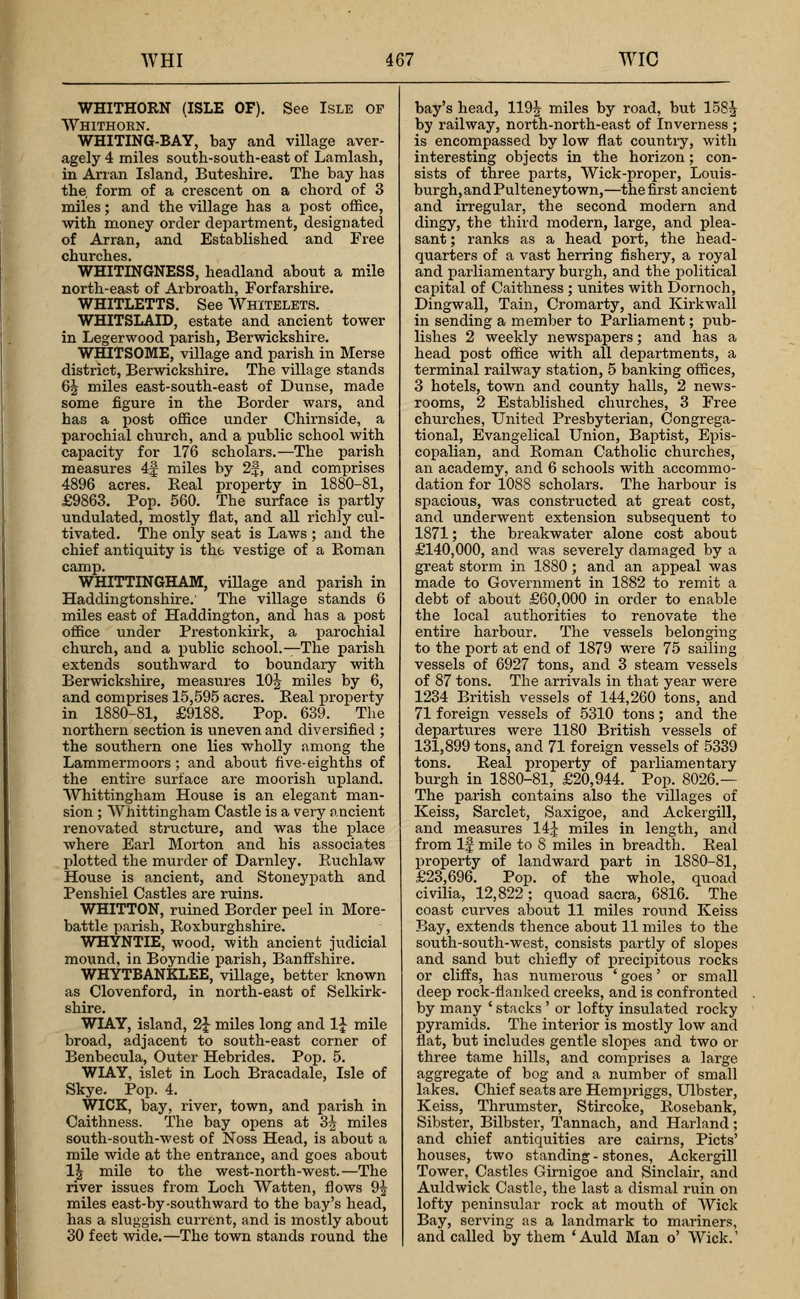WHITHORN (ISLE OF).
WHITING-BAY, bay and village averagely 4 miles south-south-east of Lamlash, in Arraii Island, Buteshire. The bay has the form of a crescent on a chord of 3 miles ; and the village has a post office, with money order department, designated of Arran, and Established and Free churches.
WHITINGNESS, headland about a mile north-east of Arbroath, Forfarshire.
WHITLETTS.
WHITSLAID, estate and ancient tower in Legerwood parish, Berwickshire.
WHITSOME, village and parish in Merse district, Berwickshire. The village stands 6J miles east-south-east of Dunse, made some figure in the Border wars, and hae a post office under Chirnside, a parochial church, and a public school with capacity for 176 scholars. The parish measures 4 miles by 2|, and comprises 4896 acres. Keal property in 1880-81, 9863. Pop. 560. The surface is partly undulated, mostly flat, and all richly cultivated. The only seat is Laws ; and the chief antiquity is the vestige of a Koman camp.
WHITTINGHAM, village and parish in Haddingtonshire. The village stands 6 miles east of Haddington, and has a post office under Prestonkirk, a parochial church, and a public school. The parish extends southward to boundary with Berwickshire, measures 10J miles by 6, and comprises 15,595 acres. Real property in 1880-81, 9188. Pop. 639. > The northern section is uneven and diversified ; the southern one lies wholly among the Lammermoors ; and about five-eighths of the entire surface are moorish upland. Whittingham House is an elegant mansion ; Whittingham Castle is a very ancient renovated structure, and was the place where Earl Morton and his associates plotted the murder of Darnley. Ruchlaw House is ancient, and Stoneypath and Penshiel Castles are ruins.
WHITTON, ruined Border peel in Morebattle parish, Roxburghshire.
WHYNTIE, wood, with ancient judicial mound, in Boyndie parish, Banffshire.
WHYTBANKLEE, village, better known as Clovenford, in north-east of Selkirkshire.
WIAY, island, 2 miles long and 1J mile broad, adjacent to south-east corner of Benbecula, Outer Hebrides. Pop. 5.
WIAY, islet in Loch Bracadale, Isle of Skye. Pop. 4.
WICK, bay, river, town, and parish in Caithness. The bay opens at 3i miles south-south-west of Noss Head, is about a mile wide at the entrance, and goes about 1^ mile to the west-north-west. The river issues from Loch Watten, flows 9J miles east-by-southward to the bay's head, has a sluggish current, and is mostly about 30 feet wide. The town stands round the bay's head, 119$ miles by road, but 158* by railway, north-north-east of Inverness ; is encompassed by low flat countiy, with interesting objects in the horizon; consists of three parts, Wick-proper, Louisburgh,andPulteneytown, the first ancient and irregular, the second modern and dingy, the third modern, large, and pleasant; ranks as a head port, the head-quarters of a vast herring fishery, a royal and parliamentary burgh, and the political capital of Caithness ; unites with Dornoch, Dingwall, Tain, Cromarty, and Kirkwall in sending a member to Parliament ; publishes 2 weekly newspapers; and has a head post office with all departments, a terminal railway station, 5 banking offices, 3 hotels, town and county halls, 2 news-rooms, 2 Established churches, 3 Free churches, United Presbyterian, Congregational, Evangelical Union, Baptist, Episcopalian, and Roman Catholic churches, an academy, and 6 schools with accommodation for 1088 scholars. The harbour is spacious, was constructed at great cost, and underwent extension subsequent to 1871; the breakwater alone cost about 140,000, and was severely damaged by a great storm in 1880 ; and an appeal was made to Government in 1882 to remit a debt of about 60,000 in order to enable the local authorities to renovate the entire harbour. The vessels belonging to the port at end of 1879 were 75 sailing vessels of 6927 tons, and 3 steam vessels of 87 tons. The arrivals in that year were 1234 British vessels of 144,260 tons, and 71 foreign vessels of 5310 tons ; and the departures were 1180 British vessels of 131,899 tons, and 71 foreign vessels of 5339 tons. Real property of parliamentary burgh in 1880-81, 20,944. Pop. 8026. The parish contains also the villages of Keiss, Sarclet, Saxigoe, and Ackergill, and measures 14J miles in length, and from 1| mile to 8 miles in breadth. Real property of landward part in 1880-81, 23,696. Pop. of the whole, quoad civilia, 12,822; quoad sacra, 6816. The coast curves about 11 miles round Keiss Bay, extends thence about 11 miles to the south-south-west, consists partly of slopes and sand but chiefly of precipitous rocks or cliffs, has numerous 'goes' or small deep rock-flanked creeks, and is confronted by many ' stacks ' or lofty insulated rocky pyramids. The interior is mostly low and flat, but includes gentle slopes and two or three tame hills, and comprises a large aggregate of bog and a number of small lakes. Chief seats are Hempriggs, Ulbster, Keiss, Thrumster, Stircoke, Rosebank, Sibster, Bilbster, Tannach, and Harland ; and chief antiquities are cairns, Picts' houses, two standing-stones, Ackergill Tower, Castles Girnigoe and Sinclair, and Auldwick Castle, the last a dismal ruin on lofty peninsular rock at mouth of Wick Bay, serving as a landmark to mariners, and called by them 'Auld Man o' Wick/ Established and Free churches are at Keiss. Eight schools for 1180 scholars are in the landward parts, and 6 of them and an enlargement for 985 are new.

